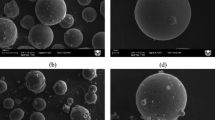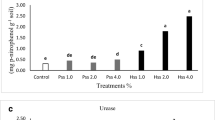Abstract
There is considerable interest in the use of coal combustion byproducts as soil liming materials in agricultural production, but there is concern that such use may be detrimental to the quality of agricultural soils. To evaluate these byproducts as liming materials and address issues related to soil quality, we compared the influence of different amounts of four combustion byproducts [fly ash and bed ash from a fluidized bed combustion furnace, lime-injected multistage burner residue, and spray dryer residue] and CaCO3 on soil pH and activities of urease, phosphatase, arylsulfatase, and dehydrogenase in an acidic soil. Studies comparing the influence of the combustion byproducts and CaCO3 on soil pH showed that on a weight basis of application, substantial differences were observed in the ability of these materials to influence soil pH but that such differences decreased markedly after the data were transformed to a CaCO3 equivalent basis of application. Analysis of covariance for these transformed data indicated that whereas the liming abilities of fly ash and CaCO3 were not significantly different when compared on the CaCO3 equivalent basis, those of bed ash, multistage burner residue, and spray dryer residue were less than that of CaCO3. Studies comparing the influence of the byproducts and CaCO3 on soil enzyme activities showed that the effect of these liming materials on the enzyme activities studied was largely due to their influence on soil pH. The relationships obtained between soil pH and enzyme activities in soil amended with the liming materials generally demonstrated the marked similarities in the influence of the combustion byproducts and CaCO3 on these activities when observed within the domain of soil pH. These studies showed that the combustion byproducts tested functioned as soil liming materials in a manner similar to that of CaCO3 and seemed to have little adverse effect on soil quality.
Similar content being viewed by others
References
Adriano DC, Page AL, Elseewi AA, Chang AC, Straugham I (1980) Utilization and disposal of fly ash and other coal residues in terrestrial ecosystems. A review. J Environ Qual 9:333–344
Carlson CL, Adriano DC (1993) Environmental impacts of coal combustion residues. J Environ Qual 22:227–247
Carter MR (1986) Microbial biomass and mineralizable nitrogen in Solonetzic soils: Influence of gypsum and lime amendements. Soil Biol Biochem 18:531–537
Dick RP (1992) Soil enzyme activities as process level biological indexes of soil quality. Agron Abstr p 253
Douglas LA, Bremner JM (1970) Extraction and colorimetric determination of urea in soils. Soil Sci Soc Am Proc 34:859–862
Gee GW, Bauder JW (1986) Particle-size analysis. In: Klute A (ed) Methods of soil analysis, Part 1. Am Soc Agron, Madison, Wis, pp 383–411
Haberern J (1992) Coming full circle. The new emphasis on soil quality. Am J Altern Agric 7:3–4
Kingston HM, Jassie LB (1988) Introduction to microwave sample preparation. Am Chem Soc, Washington DC, pp 263
Korcak RF (1985) Effect of coal combustion wastes used as lime substitutes in nutrition of apples in three soils. Plant and Soil 85:437–441
Korcak RF (1993) High gypsum byproducts as soil amendments for horticultural crops. Hort Tech 3:156–161
Lyngstad I (1992) Effect of liming on mineralization of soil nitrogen as measured by plant uptake and nitrogen released during incubation. Plant and Soil 144:247–253
Marsh BH, Grove JH (1992a) Plant and soil composition as affected by an alternative lime source containing sulfate. Soil Sci Soc Am J 56:1831–1836
Marsh BH, Grove JH (1992b) Surface and subsurface soil acidity: Soybean root response to sulfate-bearing spent lime. Soil Sci Soc Am J 56:1837–1842
Nelson DW, Sommers LE (1982) Total carbon, organic carbon, and organic matter. In: Page AL, Miller RH, Keeney DR (eds) Methods of soil analysis, Part 2. Am Soc Agron, Madison, Wis, pp 539–579
Page AL, Elseewi AA, Straugham IR (1979) Physical and chemical properties of fly ash from coal-fired power plants with reference to environmental impacts. Res Rev 71:83–120
Papendick RI, Parr JF (1992) Soil quality: The key to a sustainable agriculture. Am J Altern Agric 7:2–3
Parr JF, Papendick RI, Hornick SB, Meyer RE (1992) Soil quality: Attributes and relationships to alternative and sustainable agriculture. Am J Altern Agric 7:5–11
Phung HT, Lund LJ, Page AL (1978) Potential use of fly ash as a liming material. In: Adriano DC, Brisbin IL (eds) Environmental chemistry and cycling processes. Conference 760429, United States Department of Commerce, Springfield, Va, pp 504–514
Reganold JP, Palmer AS, Lockhart JC, Macgregor AN (1993) Soil quality and financial performance of biodynamic and conventional farms in New Zealand. Science 260:344–349
Siddaramappa R, McCarty GW, Wright RJ, Codling EE (1993) Mineralization and volatile loss of nitrogen from soils treated with coal combustion byproducts. Agron Abstr p 259
Snedecor GW, Cochran WG (1980) Statistical methods. 7th edn, Iowa State University Press, Ames, Iowa
Stout WL, Hern JL, Korcak RF, Carlson CW (1988) Manual for applying fluidized bed combustion residue to agricultural lands. ARS-74, Agric Res Serv, USDA, Washington, DC
Tabatabai MA (1982) Soil enzymes. In: Page AL, Miller RH, Keeney DR (eds) Methods of soil analysis, Part 2. Am Soc Agron, Madison, Wis, pp 903–947
Terman GL (1978) Solid wastes from coal-fired power plants: Use or disposal on agricultural lands. Bulletin Y-129, Tennessee Valley Authority, Muscle Shoals, Ala
Terman GL, Kilmer VJ, Hunt GM, Buchanan W (1978) Fluidized bed boiler waste as a source of nutrients and lime. J Environ Qual 7:147–150
Thomas GW (1982) Exchangeable cations. In: Page AL, Miller RH, Keeney DR (eds) Methods of soil analysis, Part 2. Am Soc Agron, Madison, Wis, pp 159–165
United States. Environmental Protection Agency (1988). Wastes from the combustion of coal by electric power plants. USEPA Report 530-SW-88-002, USEPA, Washington, DC
Visser S, Parkinson D (1992) Soil biological criteria as indicators of soil quality. Am J Altern Agric 7:33–37
Wright RJ, Codling EE, Siddaramappa R, Gao G (1992) The influence of coal combustion residues on soil chemical properties and root growth. Agron Abstr p 296
Yuan TL (1959) Determination of exchangeable hydrogen in soils by a titration method. Soil Sci 88:164–167
Author information
Authors and Affiliations
Rights and permissions
About this article
Cite this article
Siddaramappa, R., Wright, R.J., Codling, E.E. et al. Evaluation of coal combustion byproducts as soil liming materials: their influence on soil pH and enzyme activities. Biol Fertil Soils 17, 167–172 (1994). https://doi.org/10.1007/BF00336317
Received:
Issue Date:
DOI: https://doi.org/10.1007/BF00336317




